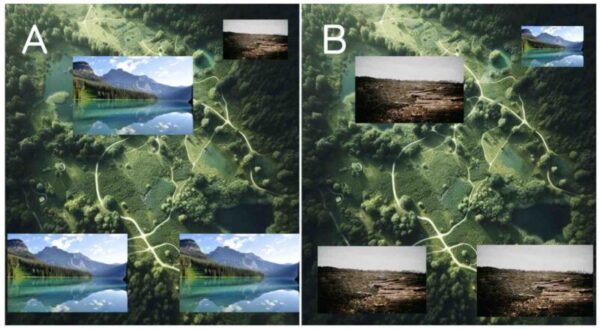COACH 101: ONLINE COACHING RESOURCES
Moving to the Empowered Mindset

In the previous article, we took a journey to the brainforest. We explored two different brainforests (picture below) and observed that in Forest A, the broader paths lead to beautiful spots, while only very few narrow paths lead to unpleasant destinations. In Forest B, the wider paths lead to unpleasant destinations, with weeds or deforestation, and beautiful destinations are barely explored.

Sometimes, our mind-brain ecosystem might resemble Forest A. When this is the case, we are accountable, feel capable of resolving our problems, are positive and pleasant to be around, and generally feel happy and satisfied with our lives. In this forest, we feel capable of steering our lives exactly where we want them to be, achieving the things we want. We are in what I define as The Empowered Mindset.
Other times, our mind-brain ecosystem might look more similar to Forest B. When this is the case, we easily fall into negativity and overthinking. We judge others, easily hold grudges, feel jealous of other’s success, lack assertiveness, and may even willing to take little revenge. In this mindset, we focus more on limitations than possibilities, feel stuck in life, full of resentment, and unable to achieve our goals. Most importantly, we lack accountability. This is what I define as The Powerless Mindset.
In summary, we can distinguish between two distinct mindsets: the powerless mindset and the empowered mindset.
To achieve healthy success, you’ll need to make sure you are thinking and acting from the empowered mindset.
How can you know if you are in the empowered mindset?
It is common not to realize when we are in the powerless mindset, as we tend to hide certain parts of ourselves from ourselves. For this reason, it is crucial to learn effective practices and mechanisms that allow us to identify when we are actually not in the empowered state of mind, as we assumed to be.
As I keep emphasizing, we all have the potential to actively transform our brainforest and lead ourselves from the powerless (Brainforest B) to the empowered (Brainforest A) state. We just need to develop the ability to do so. Up to this point, I have been focusing on the first step to achieving it, which is understanding how our mind-brain ecosystem works.
It is now time to move to the second step, which is about developing the techniques to do it.
Your external observer
In the previous article, I covered that, in a real forest, the width of the paths is determined by the number of excursionists heading in a certain direction, and in your brainforest, the excursionists are your thoughts. The more thoughts heading toward a destination, the wider the pathways will become. If certain destinations receive fewer visitors (thoughts), their pathways will narrow or even disappear.
Because this is how your mind-brain ecosystem is designed to function, it is critical that you have techniques to channel your thoughts, so they use the pathways leading to the beautiful destinations.
The first technique I’d like to explain, that you can utilize to do so, is ‘the external observer’.
The external observer involves developing the ability to observe yourself from an external, third person perspective. It means learning to observe yourself from the outside in a neutral, non-judgemental way. Once you create your external observer, you can use it to identify whether and when you are thinking and acting from the powerless state.
The external observer involves developing the ability to observe yourself from the outside, in a non-judgemental way.
I want to insist on the fact that the external observer is not there to judge you. On the contrary, its role is to detect and alert you so you can take action. The external observer helps you move from the powerless to the empowered state, doing so in a compassionate way, and never being harsh on yourself. Developing an external observer contributes to your empowerment and accountability, which are top defining qualities of the empowered state.
To develop an external observer, all you have to do is take a non-judgmental approach to yourself and look at yourself from outside, observing your thoughts as if you were a curious kid or a researcher observing a guinea pig.

Learn to observe your thoughts as if you were a curious kid or a researcher observing a guinea pig.
Catching yourself in the act
In the powerless mindset we feel victim of the circumstances and always find excuses outside ourselves to explain why things don’t go as expected for us. It is actually easy to catch yourself being in the powerless state because the type of thoughts you have are along these lines: “Of course, for him, it’s easy; his family has lots of connections!”, “If I had all the money she has, I would also be able to do it!”, “I wish I was as confident as Peter!”
Another type of thoughts you will notice in yourself whenever you are in the powerless state is related to seeing everything negatively, and focusing more on limitations than possibilities: “There is no way I will make it!”, “I will never be successful, no matter how hard I try!”, “Why are others managing, and I always fail?
Whenever you catch yourself being in the powerless state, you can kindly invite yourself to find a more empowered version of your thought, as if you were rewriting a sentence in an article that you are not satisfied with. For instance:
Powerless version of the thought: “Of course, for him, it’s easy; his family has lots of connections!”
Empowered version of the thought: “I have identified that I don’t have a strong network, and it seems important for the business, so I will focus more efforts on that.”
Don’t worry too much if you are not able to find the empowered version of the thought just yet. This is not today’s goal, and I will cover this topic more in-depth in some other occasion. For now, if you start training your external observer and manage to catch some thoughts that keep you in the powerless mindset, you can already consider it a huge success.
Key takeaways
- We can distinguish between two distinct mindsets: the powerless mindset and the empowered mindset.
- Healthy success requires positioning yourself in the empowered state very clearly.
- The first step to move to the empowered state is to understand how our mind-brain ecosystem works. The second is to develop the right mechanisms to be able to work by ourselves towards moving to the empowered state.
- One of these mechanisms is the external observer, which means developing the ability to observe yourself from an external perspective, in a non-judgemental way, as if you were a curious kid or a researcher observing a guinea pig.
Ready for a more intensive, fast, and effective process? Discover how the Conscious Self-Rewiring Coaching Method can accelerate your personal growth. Book a complimentary 30-minute discovery call with Dr. Laura to explore the Healthy Success Coaching program. Coaching sessions online. In-person coaching sessions in Dubai and the UAE.